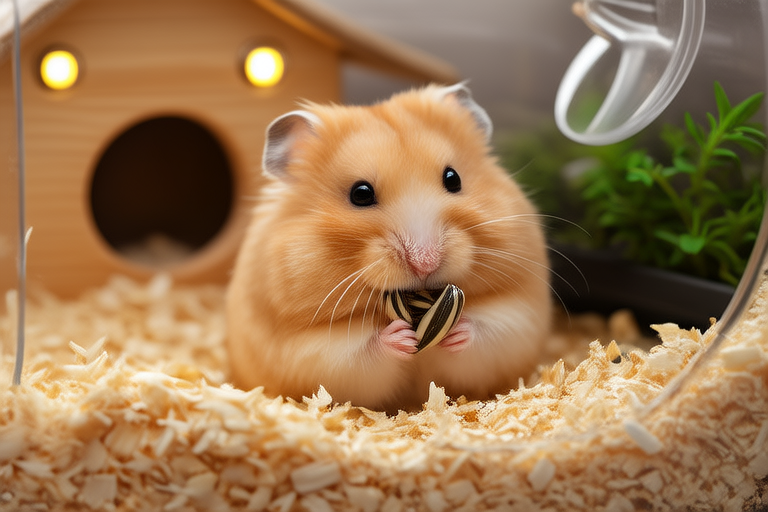How to Create the Perfect Habitat for Your Playful Golden Hamster
Golden hamsters are small, energetic creatures that require a well-thought-out habitat to thrive. This comprehensive guide will help you create the perfect environment for your playful golden hamster, ensuring they live a healthy and happy life.
Cage Size
The first step in creating the perfect habitat is selecting an appropriately sized cage. While hamsters are small, they need ample space to move around and explore. A cage that measures at least 24 inches long, 12 inches wide, and 12 inches high is recommended for a single golden hamster. Larger cages are even better as they provide more room for exercise and exploration.
Bedding Materials
Choosing the right bedding material is crucial for your hamster’s comfort and health. Avoid cedar or pine shavings as they can irritate your hamster’s respiratory system. Instead, opt for paper-based bedding or aspen shavings. These materials are safe, absorbent, and comfortable for your hamster to burrow in. Ensure the bedding is at least two inches deep to allow your hamster to dig and nest comfortably.
Toys Suitable for Their Playfulness
Golden hamsters are naturally curious and playful animals, so providing them with appropriate toys is essential. Look for toys that encourage chewing and digging, such as wooden chew sticks, tunnels, and small cardboard boxes. Puzzle feeders can also be a great way to keep your hamster mentally stimulated. Rotate toys regularly to prevent boredom and keep your hamster engaged.
Proper Food and Water Placement
Place the food dish in a corner of the cage away from the bathroom area to prevent contamination. Use a heavy ceramic dish to prevent tipping. Ensure the food is fresh and varied, including hamster pellets, seeds, and occasional treats like fruits and vegetables. Always provide fresh water daily, using a sipper bottle designed for small animals. Clean the water bottle and replace the water every day to maintain hygiene.
Hiding Spots
Golden hamsters are naturally burrowing animals and enjoy having a cozy place to retreat. Provide your hamster with a hide box or a small igloo made of wood or plastic. You can also create a DIY hide spot using a tissue box or a small cardboard box. Ensure the hide spot is large enough for your hamster to fit comfortably inside and has a small entrance hole.
Exercise Wheels
Exercise wheels are an excellent way to keep your hamster physically active. Choose a solid-surface wheel with a diameter of at least eight inches to prevent injuries to your hamster’s back and feet. Place the wheel in an area where it won’t roll off or get obstructed. Regularly check the wheel for wear and tear and replace it when necessary.
Environmental Enrichment
In addition to toys and exercise wheels, providing environmental enrichment can enhance your hamster’s quality of life. Introduce new scents, textures, and objects periodically to stimulate their senses. Rotate toys and rearrange the cage layout to keep things interesting. You can also try introducing different types of bedding or adding small, safe items like untreated twigs or leaves for your hamster to explore.
Temperature and Humidity Requirements
Golden hamsters thrive in moderate temperatures between 65°F and 75°F (18°C and 24°C). Avoid placing the cage near windows, drafts, or heating/cooling vents to prevent temperature fluctuations. Humidity levels should be maintained between 30% and 70%. Use a humidifier or dehumidifier if necessary to regulate the humidity levels in your home.
Cleaning Schedules
Regular cleaning is essential to maintain a healthy living environment for your hamster. Spot clean the cage daily by removing soiled bedding and replacing it with fresh bedding. Perform a thorough cleaning once a week, removing all bedding, toys, and accessories. Clean the cage and accessories with mild soap and water, then rinse thoroughly and dry completely before returning everything to the cage. Avoid using harsh chemicals or perfumes that could harm your hamster.
Safety Precautions
Several safety precautions should be taken to ensure the well-being of your hamster. Never leave your hamster unsupervised outside of its cage, as they may escape or encounter hazards. Keep the cage in a quiet area away from direct sunlight, drafts, and loud noises. Provide soft bedding and avoid sharp edges or rough surfaces that could injure your hamster. Regularly inspect the cage and accessories for any signs of wear and tear, and replace them as needed.
Conclusion
Creating the perfect habitat for your golden hamster involves careful consideration of their needs and preferences. By providing a spacious cage, appropriate bedding, stimulating toys, proper food and water placement, cozy hiding spots, an exercise wheel, and environmental enrichment, you can ensure your hamster lives a healthy and happy life. Additionally, maintaining the right temperature and humidity levels, adhering to a regular cleaning schedule, and taking safety precautions will contribute to your hamster’s overall well-being.
